Crying Girl is the name of two different works by Roy Lichtenstein: a 1963 offset lithograph on lightweight, off-white wove paper and a 1964 porcelain enamel on steel.
Crying Girl is the name of two different works by Roy Lichtenstein: a 1963 offset lithograph on lightweight, off-white wove paper and a 1964 porcelain enamel on steel.
During the late 1950s and early 1960s, many American painters began to adapt the imagery and motifs of comics. Lichtenstein in 1958 made drawings of comic strip characters. Andy Warhol produced his earliest paintings in this style in 1960. Lichtenstein, unaware of Warhol's work, produced Look Mickey and Popeye in 1961. [1] In the early 1960s, Lichtenstein produced several "fantasy drama" paintings of women in love affairs with domineering men, causing women to be miserable. These works served as prelude to 1964 paintings of innocent "girls next door" in a variety of tenuous emotional states. [2] Picasso's depictions of weeping women may have influenced Lichtenstein to produce portrayals of vulnerable teary-eyed women. [3] Another possible influence on his emphasis on depicting distressed women in the early to mid-1960s was that his first marriage was dissolving at the time. [4] Lichtenstein's first marriage to Isabel Wilson, which resulted in two sons, lasted from 1949 to 1965. [5]
Although single-panel comic representations depict a moment in time, both works are examples in which the moment is "pregnant" with drama related to other times. [6] This work also marks a phase in Lichtenstein's career when many of his works were named with present-participial names such as Sleeping Girl , Crying Girl and Blonde Waiting, which accentuates the works' "relation to process and action." [6]
The lithograph, which shows a crying woman with her hand near her mouth, is on lightweight, off-white wove paper. It measures 16 by 24 inches (40.6 cm × 61.0 cm). [7] This image was adapted from a comic book panel from the romance comic Secret Hearts #88 (DC Comics, June 1963), [8] in the story "Escape from Loneliness," penciled by Tony Abruzzo and inked by Bernard Sachs. [9]
Artist Chuck Close claimed to have purchased the lithograph from Leo Castelli on a visit to New York in 1963 for $10 ($100 in 2023 dollars [10] ). Close recalled the purchase: "I remember I bought [a] Roy Lichtenstein... for [ten] dollars from Leo Castelli at Lichtenstein's first [sic] show. I brought it back to Yale and I was attacked unmercifully." [11] (Lichtenstein's first solo show at The Leo Castelli Gallery in New York City, which sold out before opening, ran from February 10 through March 3, 1962. [12] [13] His second solo exhibition at the Leo Castelli Gallery ran from September 28 through October 24, 1963.) [12] [14]

The porcelain enamel on steel, which depicts a woman wiping away a tear, measures 46 by 46 inches (116.8 cm × 116.8 cm). [15] It was adapted from a story in the same romance comic, Secret Hearts #88 (DC Comics, June 1963): [16] "Exit Love--Enter Heartbreak!", drawn by Werner Roth and John Romita Sr. [17] [18]
The 1964 enamel has been held at the Milwaukee Art Museum since 1965, and is considered to be one of Roy Lichtenstein's earliest attempts at producing enamel-on-steel works from the same type of comic book imagery he had begun producing as conventional hand-painted canvases. [19]
Drowning Girl Lichtenstein.

Roy Fox Lichtenstein was an American pop artist. During the 1960s, along with Andy Warhol, Jasper Johns, and James Rosenquist, he became a leading figure in the new art movement. His work defined the premise of pop art through parody. Inspired by the comic strip, Lichtenstein produced precise compositions that documented while they parodied, often in a tongue-in-cheek manner. His work was influenced by popular advertising and the comic book style. His artwork was considered to be "disruptive". He described pop art as "not 'American' painting but actually industrial painting". His paintings were exhibited at the Leo Castelli Gallery in New York City.
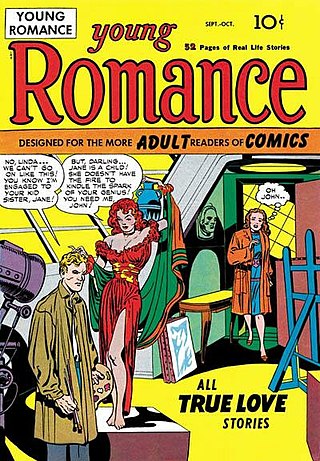
Romance comics are a genre of comic books that were most popular during the Golden Age of Comics. The market for comics, which had been growing rapidly throughout the 1940s, began to plummet after the end of World War II when military contracts to provide disposable reading matter to servicemen ended. This left many comic creators seeking new markets. In 1947, part of an effort to tap into new adult audiences, the romance comic genre was created by Joe Simon and Jack Kirby with the Crestwood Publications title Young Romance.

Whaam! is a 1963 diptych painting by the American artist Roy Lichtenstein. It is one of the best-known works of pop art, and among Lichtenstein's most important paintings. Whaam! was first exhibited at the Leo Castelli Gallery in New York City in 1963, and purchased by the Tate Gallery, London, in 1966. It has been on permanent display at Tate Modern since 2006.

Girl with Ball is a 1961 painting by Roy Lichtenstein. It is an oil on canvas Pop art work that is now in the collection of the Museum of Modern Art, after being owned for several decades by Philip Johnson. It is one of Lichtenstein's earliest Pop art works and is known for its source, which is a newspaper ad that ran for several decades and which was among Lichtenstein's earliest works sourced from pop culture.

Torpedo...Los! is a 1963 pop art oil on canvas painting by Roy Lichtenstein. When it was last sold in 1989, The New York Times described the work as "a comic-strip image of sea warfare". It formerly held the record for the highest auction price for a Lichtenstein work. Its 1989 sale helped finance the construction of the current home of the Museum of Contemporary Art, Chicago in 1991.

Look Mickey is a 1961 oil on canvas painting by Roy Lichtenstein. Widely regarded as the bridge between his abstract expressionism and pop art works, it is notable for its ironic humor and aesthetic value as well as being the first example of the artist's employment of Ben-Day dots, speech balloons and comic imagery as a source for a painting. The painting was bequeathed to the Washington, D.C., National Gallery of Art upon Lichtenstein's death.

Girl in Mirror is a 1964 porcelain-enamel-on-steel pop art painting by Roy Lichtenstein that is considered to exist in between eight and ten editions. One edition was part of a $14 million 2012 lawsuit regarding a 2009 sale, while another sold in 2010 for $4.9 million. Although it uses Ben-Day dots like many other Lichtenstein works, it was inspired by the New York City Subway rather than directly from a panel of a romance comics work.
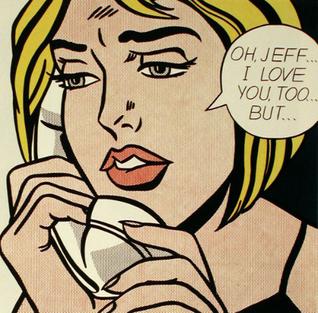
Oh, Jeff...I Love You, Too...But... is a 1964 oil and magna on canvas painting by Roy Lichtenstein. Like many of Lichtenstein's works, its title comes from the speech balloon in the painting.
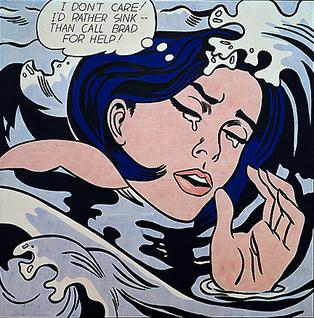
Drowning Girl is a 1963 American painting in oil and synthetic polymer paint on canvas by Roy Lichtenstein, based on original art by Tony Abruzzo. The painting is considered among Lichtenstein's most significant works, perhaps on a par with his acclaimed 1963 diptych Whaam!. One of the most representative paintings of the pop art movement, Drowning Girl was acquired by the Museum of Modern Art in 1971.

Engagement Ring is a 1961 pop art painting by Roy Lichtenstein. The work is based on the Winnie Winkle series, but Lichtenstein changed both the graphical description and the narrative accompaniment that he presents in a speech balloon. As with most of his early romance comics works, this consisted of "a boy and a girl connected by romantic dialogue and action".

Golf Ball is a 1962 painting by Roy Lichtenstein. It is considered to fall within the art movement known as pop art. It depicts "a single sphere with patterned, variously directional semi-circular grooves." The work is commonly associated with black-and-white Piet Mondrian works. It is one of the works that was presented at Lichtenstein's first solo exhibition and one that was critical to his early association with pop art. The work is commonly critiqued for its tension involving a three-dimensional representation in two dimensions with much discussion revolving around the choice of a background nearly without any perspective.
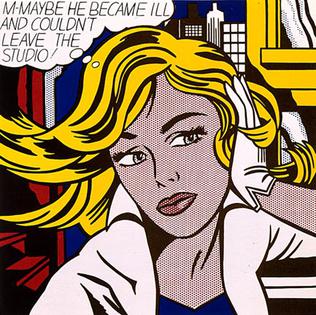
M-Maybe is a 1965 pop art painting by Roy Lichtenstein. It is one of his romance comics-based works.

In the Car is a 1963 pop art painting by Roy Lichtenstein. The smaller, older of the two versions of this painting formerly held the record for highest auction price for a Lichtenstein painting. The larger version has been in the collection of the Scottish National Gallery of Modern Art in Edinburgh since 1980.
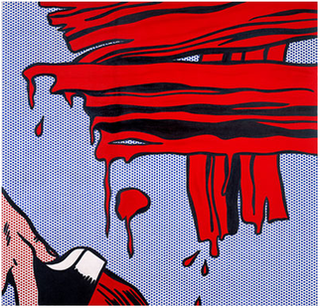
Brushstrokes is a 1965 oil and Magna on canvas pop art painting by Roy Lichtenstein. It is the first element of the Brushstrokes series of artworks that includes several paintings and sculptures. As with all of his Brushstrokes works, it is in part a satirical response to the gestural painting of Abstract Expressionism.

Hopeless is a 1963 painting with oil paint and acrylic paint on canvas by Roy Lichtenstein. The painting is in the collection of the Kunstmuseum Basel.
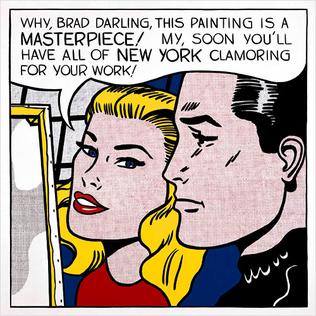
Masterpiece is a 1962 pop art painting by Roy Lichtenstein that uses his classic Ben-Day dots and narrative content contained within a speech balloon. In 2017, the painting sold for $165 million.

Varoom! is a 1963 pop art painting by Roy Lichtenstein that depicts an explosion and the onomatopoeic sound that gives it its name.

Crak! is a 1963 pop art lithograph by Roy Lichtenstein in his comic book style of using Ben-Day dots and a text balloon. It was used in marketing materials for one of Lichtenstein's early shows. It is one of several of his works related to military art and monocular vision.
Secret Hearts was a romance comic anthology published by DC Comics in the United States, primarily in the 1950s and '60s. A staple of the company's romance line, it was "one of the publisher's most successful and well-known romance titles."
Anthony Joseph "Tony" Abruzzo (1916–1990) was an American comic book artist. He is best known for his work in the romance comics field for National Periodicals, particularly Girls' Love Stories, for which he illustrated stories continuously from 1954 to 1972. In the early 1960s, pop artist Roy Lichtenstein derived many of his best-known works from the panels of romance comics that had been illustrated by Abruzzo.